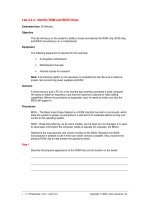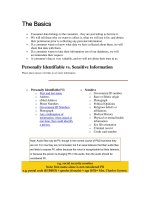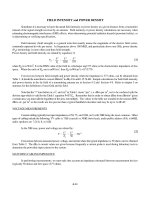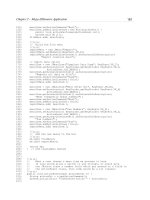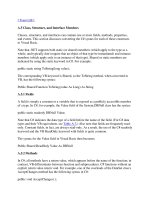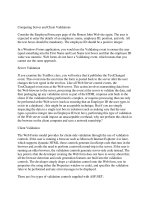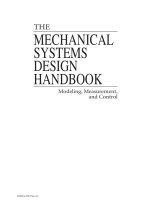Tài liệu The Alphabet and the Algorithm doc
Bạn đang xem bản rút gọn của tài liệu. Xem và tải ngay bản đầy đủ của tài liệu tại đây (4.27 MB, 182 trang )
The AlphAbeT And The
Algori
Thm
Writing Architecture series
A project of the Anyone Corporation; Cynthia Davidson, editor
Earth Moves: The Furnishing of Territories
Bernard Cache, 1995
Architecture as Metaphor: Language, Number, Money
Kojin Karatani, 1995
Differences: Topographies of Contemporary Architecture
Ignasi de Solà-Morales, 1996
Constructions
John Rajchman, 1997
Such Places as Memory
John Hejduk, 1998
Welcome to The Hotel Architecture
Roger Connah, 1998
Fire and Memory: On Architecture and Energy
Luis Fernández-Galiano, 2000
A Landscape of Events
Paul Virilio, 2000
Architecture from the Outside: Essays on Virtual and Real Space
Elizabeth Grosz, 2001
Public Intimacy: Architecture and the Visul Arts
Giuliana Bruno, 2007
Strange Details
Michael Cadwell, 2007
Histories of the Immediate Present: Inventing Architectural Modernism
Anthony Vidler, 2008
Drawing for Architecture
Leon Krier, 2009
Architecture’s Desire: Reading the Late Avant-Garde
K. Michael Hays, 2010
The Possibility of an Absolute Architecture
Pier Vittorio Aureli, 2011
The Alphabet and the Algorithm
Mario Carp0, 2o11
The MIT Press
Ca
MbrIdge,
Massa
ChuseTTs
Lond
on,
engLand
The AlphAbeT And The
Algori
Thm
Mario Carpo
© 2011 Massachusetts Institute of Technology
All rights reserved. No part of this book may be reproduced in
any form by any electronic or mechanical means (including
photocopying, recording, or information storage and retrieval)
without permission in writing from the publisher.
MIT Press books may be purchased at special quantity discounts
for business or sales promotional use. For information,
please email or write to
Special Sales Department, The MIT Press, 55 Hayward Street,
Cambridge, MA 02142.
This book was set in Filosofia and Trade Gothic by The MIT
Press. Printed and bound in the United States of America.
Library of Congress Cataloging-in-Publication Data
Carpo, Mario.
The alphabet and the algorithm / Mario Carpo.
p. cm. — (Writing architecture)
Includes bibliographical references and index.
ISBN 978-0-262-51580-1 (pbk. : alk. paper) 1. Architectural
design. 2. Architectural design—Technological innovations.
3. Repetition (Aesthetics) 4. Design and technology. I. Title.
NA2750.C375 2011
720.1—dc22
2010031062
10 9 8 7 6 5 4 3 2 1
C o n t e n t s
PrefaCe iX
1 VAriAble, idenTicAl, differenTiAl 1
1.1 Architecture and the Identical Copy: Timelines 12
1.2 Allography and N
otations
15
1.3 Authorship 20
1.4 The
Early
Modern Pursuit of Identical Reproduction
26
1.5 Geometry,
Algorism
, and the Notational Bottleneck
28
1.6 The F
all
of the Identicals
35
1.7 The Reversal
o
f the Albertian Paradigm
44
2 The rise 51
2.1 Alberti and Identical Copies 53
2.2 Going Digital 54
2.3 Windows 58
2.4
ID Pictures and the Power of Facsimiles 62
2.5 Alberti’s I
mitation Game and Its
68
Technological Failure
2.6 The I
nvention
of the Albertian Paradigm
71
3 The fAll 81
3.1 Form 83
3.2 Standard 93
3.3 Agency 106
4 epilogue: spliT Agency 123
notes 129
indeX 165
Not long ago, in the nineties, no one doubted that a “digital
revolution” was in the making—in architecture as in all aspects
of life, science, and art. Today (early 2010) the very expression
“digital revolution” has fallen into disuse, if not into disrepute;
it sounds passé and archaic, at best the reminder of an age gone
by. Yet digital technologies, now ubiquitous, have already signifi-
cantly changed the way architecture is designed and made. They
are changing how architecture is taught in schools, practiced,
managed, even regulated. Etymologically, as well as politically,
the notion of a revolution implies that something is or has been
turned upside down. It may be too soon to tell if the digital is a
revolution in architecture, but it is not too soon to ask what may
be upended if it is. If the digital is a “paradigm shift,” which para-
digm is shifting? If architecture has seen a “digital turn,” what
course has turned?
This work will trace the rise of some aspects of modernity that
have marked the history of Western architecture. They all relate
to one key practice of modernity: the making of identical cop-
ies—of nature, art, objects, and media objects of all sorts. From
the beginning of the Early Modern Age, and until very recently,
the cultural demand and the technical supply of identical copies
rose in sync. Identical copies inspired a new visual culture, and
prompted new social and legal practices aimed at the protec-
tion of the original and its owner or creator. At the same time,
new cultural technologies and new machines emerged and were
developed to produce and mass-produce identical replications:
from printed images and text set with moveable type to the
P r e fa c e
x Preface
industrial assembly line, from perspectival images to photography
to the Xerox machine.
Two instances of identicality were crucial to the shaping of
architectural modernity. The first was Leon Battista Alberti’s
invention of architectural design. In Alberti’s theory, a building
is the identical copy of the architect’s design; with Alberti’s
separation in principle between design and making came the
modern definition of the architect as an author, in the human-
istic sense of the term. After Alberti’s cultural revolution, the
second wave of identical copies in architecture came with the
industrial revolution, and the mass production of identical
copies from mechanical master models, matrixes, imprints, or
molds. Industrial standardization generates economies of scale—
so long as all items in a series are the same.
The modern power of the identical came to an end with the
rise of digital technologies. All that is digital is variable, and digital
variability goes counter to all the postulates of identicality that
have informed the history of Western cultural technologies for
the last five centuries. In architecture this means the end of nota-
tional limitations, of industrial standardization, and, more gen-
erally, of the Albertian and authorial way of building by design.
This book recounts the rise and fall of the paradigm of identi-
cality, and shows that digital and premechanical variability have
many points in common. It discusses the rise of new forms of
postindustrial digital craftsmanship by showing their relation to
hand-making and to the cultures and technologies of variations
that existed before the humanistic and modern rise of machine-
made, identical copies. The first part of the book is a synopsis of
the general argument; the second focuses on the mechanical rise
and the digital fall of identical copies. A bit of repetition is inevi-
table, but the argument is simple—symmetrical, in a sense—with
a beginning, climax, and end.
P R E F A C E xi
This chronicle situates today’s computational tools in archi-
tecture within the ambit of a centuries-old tradition, with all
of its twists and turns, of which the digital represents the most
recent. Technologies change rapidly—“new” technologies in
particular. To predict, and even interpret, new developments in
cultural technologies on the basis of their recent history is risky,
as one needs to extrapolate from a curve that is too short and
build on evidence that has not been sifted by time. A more distant
vantage point entails a loss of detail, but may reveal the outlines
of more general trends. I shall endeavor to highlight some of
these trends, and accordingly offer some conclusions—almost a
morality, as in old tales.
In addition to the many friends, colleagues, and publishers that
are mentioned in the book, special thanks are due to Megan
Spriggs, who edited earlier drafts of most chapters, to
Cynt
h
ia
Davidson, who turned those chapters into a book, and to Peter
Eisenman, who found a title for it.
1
On the evening of Sunday, August 15, 1971, U.S. President Richard
Nixon announced in a televised speech
1
a series of drastic eco-
nomic measures, including the suspension of a fixed conversion
rate between the dollar and gold. The end of the gold standard,
which had been reinstated by the Bretton Woods Agreement in
1944, had momentous economic consequences.
2
Its cultural fall-
out was equally epochal. Only a few years later, the founding
fathers of postmodernism saw in “the agony of strong referentials”
3
one of the symptoms of the postmodern condition, and Nixon’s
abolition of the dollar’s gold parity should certainly rank among
the most prominent harbingers of many postmodern “fragmen-
tations of master narratives”
4
to follow. From what is known
of him, chances are that Nixon (who died in 1994) was never
fully aware of his inspirational hold on Deleuze and Guattari’s
rhizomatic theories of mutability.
5
But from the point of view of
historians of images, the end of the dollar-gold standard should
also be noted for tolling the knell of one of the most amazing and
miraculous powers that images ever held in the history of the
West—one that art historians have often neglected.
British banking history may illustrate the relationship of paper
currency and precious metal over a longer period of time than the
history of the dollar would allow. From 1704, when banknotes
were declared negotiable in England and Wales, until—with minor
interruptions—1931, when the Bank of England in fact defaulted,
VARIABLE, IDENTICAL, DIFFERENTIAL
2
any banknote issued by the Bank of England could be converted
into gold or sterling silver at a fixed rate: paper stood for metal
and one could be exchanged for the other at the same rate at any
time. After Bretton Woods the British pound was pegged to the
American dollar, and the dollar to gold, which, if one reads this
story in British history books (and in Ian Fleming’s Goldfinger),
6
means that the pound was once again on a gold standard, and if
one reads it in American books means that the British pound was
pegged to the dollar. Either way, the statement that still appears
in small print on British banknotes—“I promise to pay the bearer
on demand the sum of” £10, for example—before 1971 meant that
the bearer would be paid on demand an amount of metal con-
ventionally equivalent to ten pounds of sterling silver; as of 1971
and to this day, the same phrase means, somewhat tautologically,
that the Bank of England may replace that banknote, on demand,
with another one.
7
The almost magic power of transmutation whereby paper
could be turned into gold was canceled, apparently forever, on
that eventful late summer night in 1971. For centuries before
Nixon’s intervention that alchemical quality of legal tender was
guaranteed by the solvency of an issuing institution, but bestowed
upon paper by the act of printing. For that miraculous power of
images did not pertain to just any icon, but only to very particular
ones: those that are identically reproduced, and are visually rec-
ognizable as such. Identicality and its instant visual recognition
are what used to turn paper into gold; and identicality still makes
legal tender work the way it does. A banknote that is not visually
identical to all others in the same mass-produced series (with
the exception of its unique serial number) may be fake or worth-
less. And as we have seen plenty of identical banknotes, until very
recently we were expected to be able to tell at first sight when
one is different, or looks strange, and reject it. Before the age of
VA R I A B L E , I D E N T I C A L , D I F F E R E N T I A L 3
banknotes, the same pattern of visual identification applied to
coins and seals, whose value and identification depended on the
sheer indexicality of a mechanical imprint, and on the cultural
and technical assumption that all valid copies could and would
be reproduced identically.
These instances of “indexical” sameness—a quintessential
feature of the mechanical age, and of mechanical reproducibil-
ity itself—are in direct contrast with other paradigms of vision
that both preceded and followed the age of mechanical copies.
To keep to monetary examples, the variability of artisanal hand-
making survives today in personal checks, where the authority
of the bank is attested to by the part of the check that is printed,
but the validity of the check is triggered only by the manuscript
signature of the payer.
Like
all things handmade, a signature is
a visually variable sign, hence all signatures made by the same
person are more or less different; yet they must also be more or
less similar, otherwise they could not be identified. The pattern
of recognition here is based not on sameness, but on similar-
ity. Similarity and resemblance, however, are complex cognitive
notions, as proven by the history of mimesis in the classical tra-
dition, both in the visual arts and in the arts of discourse. Even
today’s most advanced optical readers cannot yet identify nor
authenticate personal signatures, and not surprisingly, personal
checks are neither universal nor standard means of payment
(unless the bearer can be identified by other means, or is known
in person, and trusted).
In the world of hand-making that preceded the machine-
made environment, imitation and visual similarity were the
norm, replication and visual identicality were the exception. And
in the digital world that is now rapidly overtaking the mechanical
world, visual identicality is quickly becoming irrelevant.
Cred
i
t
cards may well be in the shape of a golden rectangle (or a fair ap-
4
proximation thereof: it is not known whether this happened by
chance or by design), and still bear logos, trademarks, and some
archaic machine-readable characters in relief—a reminder of the
time when they were invented in the late fifties. But today the
validity of a credit card depends almost exclusively on a unique
string of sixteen digits that identifies it, regardless of its format,
color, or the material of which the card is made.
8
Indeed, for
online transactions the physical existence of the card is neither
required nor verifiable. The first way to confirm the validity of
a credit card is to run a check on the sixteen-digit sequence of
its number using a simple algorithm, known as
Luhn
’
s formula,
which in most cases (statistically, nine times out of ten) is enough
to detect irregularities. No one would try to judge the creditwor-
thiness of a credit card by looking at it, in the way one would pe-
ruse a banknote or inspect its watermark. Visual identification is
now out of the game. In this instance, exactly transmissible but
invisible algorithms have already replaced all visual and physical
traces of authenticity.
Albeit anecdotal, these monetary examples illustrate three
paradigms of visual identification, essentially related to three
different ways of making things. The signature, the banknote,
and the credit card: when objects are handmade, as a signature
is, variability in the processes of production generates differ-
ences and similarities between copies, and identification is
based on visual resemblance; when objects are machine-made,
as a banknote is, mass-produced, exactly repeatable mechani-
cal imprints generate standardized products, and identification
is based on visual identicality; when objects are digitally made,
as are the latest machine-readable or chip-based credit cards,
identification is based on the recognition of hidden patterns, on
computational algorithms, or on other nonvisual features. This
loss of visuality, which is inherent in the mode of use of the latest
VA R I A B L E , I D E N T I C A L , D I F F E R E N T I A L 5
generation of credit cards, may in turn be a prelude to the even-
tual disappearance of the physical object itself: credit cards are in
most cases already obsolete, as many of their functions may soon
be taken over by cell phones, for example.
The list of objects of daily use that have been phased out by
digital technologies is already a long one: digital consumer appli-
ances tend to merge on a single, often generic technical platform
a variety of functions that, until recently, used to be performed
by a panoply of different manual, mechanical, or even electronic
devices (from address books to alarm clocks to video players).
Industrial designers and critics have taken due notice, as is
shown by the ongoing debate on the disappearance of the object
(or at least of some objects).
9
However, alongside and unrelated
to this seemingly inevitable wave of product obsolescence—or
perhaps, more appropriately, product evanescence—digital tools
are also key in the design and production of a growing range of
technical objects, old and new alike—from marble sculptures to
silicon chips. And the technical logic of digital design and pro-
duction differs from the traditional modes of manufacturing and
machinofacturing in some key aspects.
A mechanical machine (for example, a press) makes objects.
A digital machine (for example, a computer) makes, in the first
instance, a sequence of numbers—a digital file. This file must at
some later point in time be converted into an object (or a media
object) by other machines, applications, or interfaces, which
may also in turn be digitally controlled. But their control may be
in someone else’s hands; and the process of instantiation (the
conversion of the digital script into a physical object) may then
be severed in space and time from the making and the makers
of the original file. As a consequence, the author of the original
script may not be the only author of the end product, and may not
determine all the final features of it.
6
To go back to image theory, a comparison may help to make
the point. Each print of a picture in the same print run looks the
same. All mass-produced series include minor accidental vari-
ances, but by and large, all buyers of the same postcard (printed,
for example, in one thousand copies) will buy the same picture.
On the contrary, a digital postcard, e-mailed from a computer to
an electronic mailing list of one thousand recipients, is sent as a
sequence of numbers that will become a picture again only upon
delivery—when it appears on one thousand different computer
screens, or is printed out by as many different printers. The digi-
tal file is the same for all. But each eventuation of that file (in this
instance, its conversion into a picture) is likely to differ from the
others, either by chance (some recipients may have different ma-
chines and applications), or by design (some recipients may have
customized their machines or may deliberately alter the picture
for viewing or printing). Some of this customizable variability
certainly existed in the good old days of radio and television, and
even of mechanically recorded music. But the degree of variabil-
ity (and indeed, interactivity) that is inherent in the transmis-
sion and manipulation of digital signals is incomparably higher.
We may well send the same digital postcard to all our friends. Yet
there is no way to anticipate what each of them will actually see
on the screen of his or her computer or cell phone (and even less,
what they will see if they decide to print that picture on paper—or
on any other material of their choice, for that matter).
The loss of visual significance that is so striking in the in-
stance of the credit card may simply be the terminal phase of the
general regime of visual variability—or sensorial variability if we
include other senses beyond sight—that characterizes all digital
environments. Variability is also a diacritical mark of all things
handmade, but artisanal and digital variability differ in another
essential feature. Handmade objects can be made on demand,
VA R I A B L E , I D E N T I C A L , D I F F E R E N T I A L 7
and made to measure. This makes them more expensive than
comparable mass-produced, standardized items, but in com-
pensation for their extra cost, custom-made objects are as a rule
a better fit for their individual user. In other instances, however,
artisanal variability may be a problem, rather than a solution.
As hand-making is notoriously ill suited to delivering identical
copies, this tends to be the case whenever identical copies are
needed. To take an obvious example: before the invention of
print the transmission of texts and images was at the mercy of the
will and whims of individual copyists, who could make mistakes
and unpredictable changes at all stages of the copying process.
The inevitable random drift of all manually reproduced texts and
images was for centuries a major impediment to the recording
and the transmission of all sorts of cultural artifacts—from poetry
and music to science and technology.
Some degree of randomness is equally intrinsic to all digital
processes. In most cases, we don’t know which machines will
read the digital file we are making, or when, or what technical
constraints or personal idiosyncrasies will ultimately determine
the conversion of our work from machine-readable documents
into something readable (or otherwise perceptible) for humans.
But, to a much greater extent than was conceivable at the time of
manual technologies, when every case was dealt with on its own
merit, and individual variations were discussed, negotiated, and
custom-made on demand, the very same process of differentia-
tion can now be scripted, programmed, and to some extent de-
signed. Variability can now become a part of an automated design
and production chain. Indeed, this is what the most alert users
of digital technologies have been doing for the last fifteen years
or so—artists and technologists as well as entrepreneurs and
capitalists.
8
Both the notions of a manual drift in artisanal and script cul-
tures, and of a digital drift in contemporary computer-based
environments, will be discussed at length in the central chapters
of this book. But a simpler instance of digital “differentiality” (a
term introduced by Greg
Lynn
to describe the new forms of serial
variations in the digital age)
10
may clarify the matter here. As is
well known, various features of many web pages are now auto-
matically customized based on what the page makers know of each
individual page user. This is why the advertising (and increas-
ingly, the content) which appears on some of the most popular
web sites differs based on the computer, the browser, network,
or protocol we use to access those pages, and varies according to
the time of day, the geographical location of the user, and a num-
ber of other arcane factors that are well-protected trade secrets.
This is, at its basis, the golden formula that has made Google a
very rich company.
11
Variability, which could be an obstacle in
a traditional mechanical environment, where identical copies
were pursued, expected, and had intrinsic value, has been turned
into an asset in the new digital environment—indeed, into one of
its most profitable assets. As content customization seems to be,
for the time being, almost the only way to make digital content
pay for itself, web users are learning to cope with its side effects.
Readers of the same online edition of the same newspaper often
end up reading, at the same time and in the same place, a per-
manently self-transforming hodgepodge of different texts and
images (sounds can be added at will). Following on the same
logic, experiments are reportedly underway to replace conven-
tional printed billboards in public places with electronic ones,
capable of detecting certain features of the onlookers standing
in front of them (through physical or electronic markers) and
adapting their content accordingly.
12
There was a time when daily newspapers published more than
one local edition (and a few still do); but the notion that each
VA R I A B L E , I D E N T I C A L , D I F F E R E N T I A L 9
reader may find his or her own custom-made newspaper (or web
portal, or advertisement in a railway station) to match his or her
unique profile goes far beyond technical variability, or digital
differentiality, and induces a feeling of cultural instability that
many may find disturbing. Over the course of the last five cen-
turies the “typographical man” became increasingly dependent
upon a high degree of visual predictability to facilitate the storage
and retrieval of written information. Visual and graphic stability
in the layout of texts and images arose with print technology, and
thence spread to all tools and instruments that were mechani-
cally mass-produced (again, printed from the same matrix or
mold). These same patterns of graphic recognition are still at the
basis of many cultural and social practices that play an important
role in the ordinary conduct of our daily lives. We used to look
for a certain column (or index, or price) in the same place on the
same page of the same newspaper; similarly, certain electrome-
chanical interfaces, such as analog instrument panels with dials
and gauges, used to assign specific data sources to fixed, distinct,
and memorable visual loci (as in all cars of the same make, for
example, where a given warning signal always lights up in the
same place, form, and color on the dashboard).
None of this applies to digital interfaces, where even the
fonts and sizes of alphabetical texts may change anytime, often
without warning, and the same piece of information may pop up
anywhere on the isotropic surface of a muted
display or of
an interactive control panel, in all kinds of different sensorial
species (as sounds, pictograms, drawings, diagrams, alphabeti-
cal warnings in a variety of different languages, perfectly impen-
etrable numerical error codes, etc.). Indeed, there is a certain
logic in that the company that most contributed to the variabil-
ity of digital images (Adobe Systems, the makers of Photoshop)
should also have created new software specifically to counter this
digital drift—to freeze images and force users to view visually
10
identical graphic layouts. Adobe’s , or “portable document
format,” essentially uses web technologies to transmit electronic
photocopies—faxes sent over the Internet. Not without success:
clearly, in many instances our societies cannot yet do without
the iron inflexibility of the typographical page—a mechanical at-
tribute par excellence. Tax forms must be identical for all (even
when downloaded from a web site, or, more recently, filled in
online) because line 33
A-14 must appear on page 7 on all tax re-
turns. This clearly shows how income tax returns could not have
existed before the age of printing: even in the electronic era the
internal revenue services of most countries, when they go online,
are forced to use the most sophisticated technologies to reduce
the ectoplasmic variations of digital images to the mechanical
fixity of printed pages. The web sites of various ministries and
national services that deal with tax returns are true works of elec-
tronic art, and Marshall Mc
Luha
n
would have delighted in the
digital emulation of Gutenberg’s machine recently perfected by
modern state bureaucracies: the typographical man is so integral
to the modern state that the modern state, even after adopting
electronic technologies, is forced to perpetuate a mimesis of the
typographical world.
13
So it seems, to sum up, that in the long duration of historical
time the age of mass-produced, standardized, mechanical, and
identical copies should be seen as an interlude, and a relatively
brief one—sandwiched between the age of hand-making, which
preceded it, and the digital age that is now replacing it. Hand-
making begets variations, as does digital making; but the capacity
to design and mass-produce serial variations (or differentiality)
is specific to the present digital environment. Unlimited visual
variability, however, may entail a loss of visual relevance: signs
that change too often or too randomly may mean less, individu-
ally taken, and may in the end lose all meaning.
14
This was al-
VA R I A B L E , I D E N T I C A L , D I F F E R E N T I A L 1 1
ready the case in the old age of handmade variability, when the
economy of visual communication was dysfunctional because of
a penury of recognizable images, and is again the case in the new
age of digital differentiality, where the economy of visual com-
munication is dysfunctional because of an oversupply of variable
images.
The sequential chronology of these three technical ages (the
ages of hand-making, of mechanical making, and of digital mak-
ing) lends itself to various interpretations.
15
Some objects were
still handmade well into the mechanical age, and some will still
be handmade, or mechanically made, well into the age of digital
making. But, by and large, the second break in this sequence,
the passage from mechanically made identical copies to digitally
generated differential variations, is happening now. The first
break, the transition from artisanal variability to mechanical
identicality, occurred at different times in the past—depending
on the classes of objects and technologies one takes into account.
The defining shift from artisanal hand-making to mechanical
manufacturing (or machinofacturing) came with the industrial
revolution. However, if next to traditional objects of manufac-
turing (rails, sewing machines, or automobiles) we also look at
media objects (texts, images, sounds, and their modes of record-
ing and transmission), we may encounter some slightly different
chronologies.
New media theorists
16
tend to situate the transition from vari-
able to identical copies in the nineteenth or twentieth century,
as they associate the rise of identicality with indexical realism,
which is often seen as the distinctive property of photography and
of cinema. Unlike an artist’s drawing, a photographic image is a
machine-made, quasi-automatic imprint of light onto a photo-
sensitive film: by the way it is made, it can only record something
that really happened. Traditional media scholars
17
relate the rise
12
of identically reproduced, mechanical images to the invention of
print and—almost simultaneously—of geometrical perspective in
the Renaissance. Well before modern photographic technologies,
Alberti first and famously defined perspectival images as the
trace of light rays on a surface.
The history of architecture features a conflation of different
technological timelines. Built architecture depends on the pro-
duction of material objects (bricks, nails, iron beams, etc.), hence
its modern history is linked to the traditional chronology of the
industrial revolution. On the other hand, architectural design is
a purely informational operation, and its processes are defined
by a specific range of cultural and media technologies. For cen-
turies the classical tradition was based on the recording, trans-
mission, and imitation of architectural models. In turn, this
tradition, or transmission, was and still is dependent on the
media technologies that are available, at any given point in time,
to record a trace of such models and to transmit them across
space and time. What cannot be recorded will not be transmitted,
and what is neither recorded nor transmitted cannot be imitated.
Additionally, and unrelated to the publication, circulation, and
reception of architectural rules and models, building may also be
dependent on the cultural technologies needed to notate specific
design instructions that are conceived by some to be carried out
by others, sometimes in the absence of the original designer. A
key issue in the modern, notational theory of architectural design,
this technical, point-to-point exchange of building and construc-
tion data is once again a matter of recording and transmission—a
media problem.
1.1 Architecture and the Identical Copy: Timelines
The history of architecture in the machine age is well known. As
it has been written and rewritten many times over by the militant


